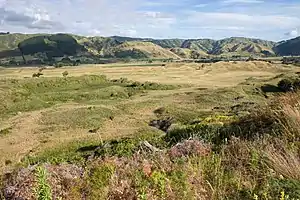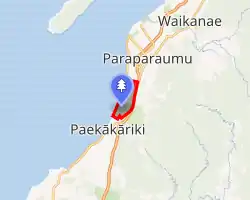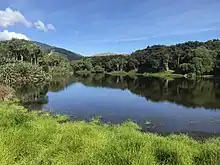Queen Elizabeth Park, New Zealand
Queen Elizabeth Park is a Wellington Regional Park located on the Kapiti Coast in New Zealand. The park contains the last area of natural dunes on the Kapiti Coast.[1]
| Queen Elizabeth Park | |
|---|---|
 Queen Elizabeth Park, looking towards State Highway One | |
 | |
| Type | Regional park |
| Location | Kapiti Coast, New Zealand |
| Coordinates | 40.964928°S 174.969335°E |
| Area | 638 hectares (1,580 acres) |
| Created | 1953 |
| Operated by | Wellington Regional Council |
| Open | 8am-dusk |
| Status | Open |
Geography
The park is bordered by Paekakariki, Raumati South, two state highways (SH 1 and SH 59), and the North Island Main Trunk Railway.
The main entrance is at Mackays Crossing; secondary entrances are in Raumati South and Paekakariki.[1]
History
The park is steeped in history including pā sites at Whareroa Beach and Wainui Beach. The tangata whenua of the park are Ngati Haumia, a hapu of the Ngāti Toa iwi and Te Atiawa ki Whakarongotai,[2] who occupied the area for hundreds of years until the mid-19th century.[3]
The number of European settlers grew during the 1830s, and European farmers started to dominate the area from the mid-1850s.[3]
During World War II, the park was the location of two United States Army and Marines bases, Camp MacKay and Camp Russell. U.S. troops were stationed at the camps in 1942–44 prior to being sent into combat in the Pacific Ocean theatre. Today, little evidence of the 20,000 strong military camps remains.[2][4]
The park was named for Queen Elizabeth II before her coronation and was opened during the 1953 Royal Visit. Many recreation facilities were developed in the 1950s and 1960s.[2]
Restoration of wetland

Two areas of wetland were created within the park in the 2000s near Mackay's Crossing, using excavation and plantings to restore the habitat. There is a renmant of native bush adjacent to the restored wetland.[5]
In 2021, about 25 hectares (62 acres) of highly modified peat land on the north-eastern corner of the park was replanted, to restore it to wetland and native forest by about 2026.[6][7] Environmentalists wanted other farmland in the regional park to also be restored to wetland.[8]
Recreation
Several expansive lawn areas near Whareroa Beach and the southern entrance at Paekakariki provide plenty of space for picnics and recreational activities. Public toilets are located at the car parks at the end of the road to Whareroa Beach, and near the playground and car parks at the Paekakariki entrance.[1]
A coastal walkway and an inland walkway run the length of Queen Elizabeth Park from Raumati South to Paekakariki. Near the main entrance, a loop walkway leads through a wetland area and bush remnant with mature kahikatea.[1]
The park also includes Wellington Tramway Museum and several campgrounds.[1]
The park is open from 8am to dusk, year-round. Dogs are permitted, but must be kept on a leash in picnic areas and are not permitted on or near farmland. Fireworks are prohibited at all times.[1]
References
- "Queen Elizabeth Park". gw.govt.nz. Wellington Regional Council. Archived from the original on 23 October 2021. Retrieved 25 April 2022.
- "Queen Elizabeth Park History". gw.govt.nz. Wellington Regional Council. Archived from the original on 21 December 2019. Retrieved 21 December 2019.
- Willis, Rosalie (30 December 2019). "Lots to do at Queen Elizabeth Park on Kāpiti Coast". New Zealand Media and Entertainment. New Zealand Herald. Archived from the original on 12 September 2021. Retrieved 25 April 2022.
- "The Camps". nzhistory.net.nz. Ministry for Culture and Heritage. Archived from the original on 21 October 2008. Retrieved 28 December 2008.
- "Queen Elizabeth Park Resource Statement" (PDF). Greater Wellington Regional Council. November 2008. Archived (PDF) from the original on 9 February 2022. Retrieved 25 April 2022.
- "Final planting just the beginning for Queen Elizabeth Park". New Zealand Media and Entertainment. New Zealand Herald. 9 July 2020. Archived from the original on 12 September 2021. Retrieved 25 April 2022.
- Gaylor, Penny (30 September 2020). "Restoration work in popular park means big win for environment". New Zealand Media and Entertainment. Kapiti News. Archived from the original on 12 September 2021. Retrieved 25 April 2022.
- Wannan, Oliva (3 March 2020). "Queen Elizabeth Park wetlands restoration delay could cost thousands of tonnes of carbon dioxide". New Zealand Media and Entertainment. Dominion Post. Archived from the original on 12 September 2021. Retrieved 25 April 2022.
External links
![]() Media related to Queen Elizabeth Park, New Zealand at Wikimedia Commons
Media related to Queen Elizabeth Park, New Zealand at Wikimedia Commons
![]() Media related to Camp McKay, Paekakariki at Wikimedia Commons
Media related to Camp McKay, Paekakariki at Wikimedia Commons
- Queen Elizabeth Park at Greater Wellington